|
 Flammulina stratosa Flammulina stratosa
BiostatusPresent in region - Indigenous. Endemic
Images (click to enlarge)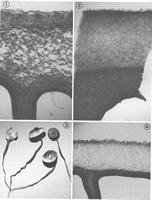
Caption: Figs. 1-4. Flammulina species. Fig. 1. Tangential section of a pileus of F. velutipes
(topotype material from England, K 28262) stained in phloxine in KOH solution,
showing one lamella at the bottom, dense nongelatinized tissues associ | 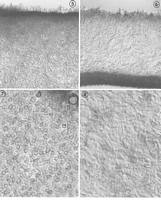
Caption: Figs. 5-8. Flammulina similis and F. stratosa pilear tissues. Fig. 5. Additional details of
suprapellis and mediopellis of F. similis shown in Fig. 2. Fig. 6. Additional detail of
suprapellis, mediopellis, subpellis, and pilea | 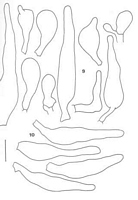
Caption: Figs. 9 and 10. Flammulina stratosa (holotype). Fig. 9. Pileipellis elements (beaked
pileocystidia and clavate elements). Fig. 10. Cheilocystidia. Bar scale = 10 µm. | 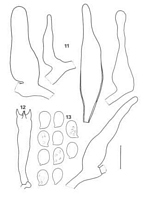
Caption: Figs. 11-13. Flammulina stratosa (holotype). Fig. 11. Caulocystidia. Fig. 12. Basidium. Fig.
13. Basidiospores. Bar scale = 10 µm. | 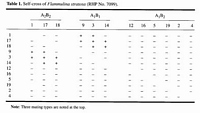 |
Article: Redhead, S.A.; Petersen, R.H.; Methven, A.S. (1999) [1998]. Flammulina (Agaricales): F. stratosa, a new New Zealand species distantly related to the cultivated Enoki mushroom. Canadian Journal of Botany 76(9): 1589-1595.
Description: Pileus 10-15 mm in diameter, convex to broadly convex, with or without a broad low umbo;
surface subviscid to tacky, radially translucent striate to undulate, glabrous; margin incurved,
irregular to even; disc colored "Orange Rufous" to "Sanford Brown"; margin colored
"Orange-Buff" to "Light Orange-Yellow." Lamellae adnexed to slightly adnate in age, distant,
thin, up to 5 mm broad; edges even, not marginate; lamellulae in 3-4 tiers, not forked; color
"Pale Yellow- Orange," not staining. Stipe 50-65 mm long, 1-2 mm wide, terete, equal
above, radicating, tapering gradually to a firm point below, conspicuously undulating in a
corkscrew fashion on the lower half (Fig. 3), and having the appearance of a criniform
pseudorhizae of a Phaeocollybia (Phaeocollybia attenuata group); moist to dry but not
viscid, surface pruinose to pubescent, with a slight sheen beneath the pruinosity, apically
coloured "Pale Yellow-Orange" to "Orange-Buff," nearly black or blackish brown for
most of its length except for a pallid yellowish hoar at the very base. Odor and taste not
distinctive.
Pileus tissues (Figs. 4, 6, and 8) consisting of three distinctive layers: (1) a relatively thin
suprapellis 22-36 µm thick (in Melzer's), (2) an exceedingly thick mediopellis, 325335
µm deep, and (3) a relatively thin, tough, true context, 85-95 µm deep.
(1) Suprapellis palely pigmented yellowish brown, consisting of two cell categories (Fig.
9): (A) a palisade-like layer of well-spaced, erect to somewhat collapsed, more or less
short clavate, pedicellate-clavate, mucronate-clavate, eccentrically rostrate-clavate, or
occasional short lageniform end cells, all embedded in a gel, each in the range of 9-20(-30) µm long,
and 4.5-8 µm wide where swollen, with thin hyaline to faintly melleous
colored walls and frequently internally guttulate and (B) scattered 25-61 µm long, 6.5-13.5 µm
wide where swollen projecting pileocystidia, lageniform with a fusoid base,
either short stalked or pedicellate with a narrow stalk and with apices projecting 13-27
µm above the gel; walls tending to be more heavily brownish pigmented as viewed in 2%
KOH solution, slightly thicker and more readily taking up Congo Red stain than the
palisade cells.
(2) Mediopellis a very conspicuous, thick, hyaline, gelatinous layer replacing the context
as the main structural tissue; 1- to 3 µm-diameter hyphae distantly spaced in the gel, with
conspicuous clamp connections and a sheath of slightly more refractive gel close to their
otherwise smooth thin walls. An indistinct subpellis composed of slightly denser tissue
than that of the context is vaguely discernable at the transition zone.
(3) Context a thin layer resembling a subhymenial layer because of its thinness and
proximity to the hymenium and the tissue's extension into the lamellae; hyphae a dense
mixture of thin-walled often frequently branched and interwoven, noninflated cells,
mostly highly internally refractive and oleiferous, hence very opaque, silvery to golden,
and oily.
Lamellar trama tissue similar to the context, i.e., dense, oily. Subhymenium a thin zone
of more densely branched hyphae with fewer oleiferous elements. Basidia 29-31 x 4.56.5
µm, clavate, hyaline, clamped, 4-spored (Fig. 12); sterigmata 2.5-3.0 µm long.
Pleurocystidia not seen. Cheilocystidia 35-41 x 7-8 µm, forming a dense sterile lamellar
margin; size, shape and wall staining similar to that of pileocystidia, hyaline, lageniform,
fusoid-ventricose, with or without a pedicellate base (Fig. 10).
Basidiospores 5.5-7.5 x 4.5-6.0 µm (mean of 10 spores = 6.52 x 4.85 µm, Q = 1.34),
broadly ellipsoid to slightly ovoid, slightly obovoid, or very broadly lacrymoid, smooth,
thin walled, hyaline, nonamyloid, with a prominent apiculus (Fig. 13).
Stipitipellis a layer of parallel 3- to 4 µm-diameter filamentous hyphae at the stipe apex,
honey colored to hyaline, with subgelatinized walls and interhyphal spaces, darkening
lower on the stipe to dark reddish blackish brown and becoming brittle, giving rise to
solitary to clustered caulocystidia or cystidioid branches. Caulocystidia 22-50 x 4.5-12
µm, typically lageniform, some narrow, some broad, a few subcapitate, with broad or
narrow bases (Fig. 11), initially hyaline but darkening like the stipe, with slightly
thickened walls. Stipe inner cortical hyphae on lower stipe contrasting sharply with the
superficial cortical hyphae in color, 3.5-11.0 µm in diameter, honey colored, with
subgelatinized walls; mixed with scattered refractive oleiferous hyphae. Hyphae of basal
pruina actually elongated cystidioid hair ends, 2.3-2.7 µm in diameter, with thickened
reddish brown walls.
CULTURES: Self-cross: When 12 single-basidiospore isolates were paired in all
combinations, a tetrapolar mating system was revealed (Table 1). Isolates 3*, 9, 14 =
A1B 1;1*, 17, 18 = A2B2; 2*, 4, 5, 12, 16, 17 = A1B2;
A2B 1 was unrepresented in the sample. Only
isolates 3 and 17 gave consistent positive readings where expected. Single-basidiospore
isolates grew extremely slowly and weakly, with colonies taking over 3 months to make
contact and over 5 months to form a wellformed contact zone. Exemplars of F. stratosa
tested negative against all other available Flammulina exemplars as part of a larger study
that will be detailed elsewhere.
CULTURE MORPHOLOGY: Colonies were characterized by the following. (1) Narrow or
torulose appressed to submerged hyphae, almost empty except for scattered pale tan guttules.
(2) Desiccated aerial hyphae. (3) Conidia produced in two ways: (A) within 0.5- to 1.5-mm-diameter
dark brown to brownish black balls covered with a leathery rind (textura intricata)
with caulocystidia-like structures covering the entire surface (once the rind was ruptured, the
firm but moist mass of conidia could be smeared across the agar) and (B) in somewhat slimy
heads on aerial conidiophores. While the mode of conidial formation is unknown, groups of
conidia were observed to resemble "hands of bananas", similar to that seen when conidia are
formed sympodially. Conidia ellipsoidal, smooth, tan (brown in mass). (4) In most pairings,
the agar turned brown with slight pinkish cast, either limited to the contact zone or starting
there. (5) Color of contact zones of all compatible pairings remained white to very pale
(unchanged from color of agar), often with no discernable seam in the contact zone. It should
be noted that although putatively incompatible pairings were also white, clamp connections
were so difficult to see in all pairings that some pairings scored as incompatible may actually
have been compatible.
Habitat: HABITAT: Subcespitose, fruiting out of a knothole in a standing, living, mature
Nothofagus tree that otherwise appeared to be healthy.
|